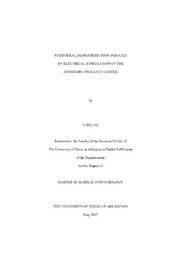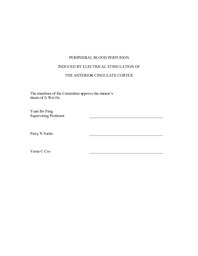
ATTENTION: The works hosted here are being migrated to a new repository that will consolidate resources, improve discoverability, and better show UTA's research impact on the global community. We will update authors as the migration progresses. Please see MavMatrix for more information.
Show simple item record
| dc.contributor.author | He, Ji Wei | en_US |
| dc.date.accessioned | 2007-08-23T01:56:15Z | |
| dc.date.available | 2007-08-23T01:56:15Z | |
| dc.date.issued | 2007-08-23T01:56:15Z | |
| dc.date.submitted | April 2007 | en_US |
| dc.identifier.other | DISS-1664 | en_US |
| dc.identifier.uri | http://hdl.handle.net/10106/193 | |
| dc.description.abstract | In the last decade, much research has implicated the anterior cingulate cortex
(ACC) in the modulation of both emotion and visceral functions in primates and rats.
Rat studies have shown that electrical stimulation of the ACC suppresses animal’s
behaviors associated with noxious stimuli, and inhibits spinal cord dorsal horn neuron
activity induced by nociception in the periphery. Electrical stimulation of the
periaqueductal grey (PAG) is reported to inhibit spinal cord dorsal horn neuron activity
induced by nociception, while it generates dorsal root reflex (DRR). This is an
important contributor to peripheral vasodilatation, i.e. leading to increased blood flow.
The purpose of the present study is to investigate whether electrical stimulation of the
ACC will evoke DRR, which would provide some evidence of communication between
the ACC and the PAG involved in inhibition of nociception. Preliminary experiments indicated no change of DRR after electrical stimulation of the ACC. However, a biphase
change of cutaneous blood perfusion was associated with the stimulation. During
the 60 second stimulation and right after the stimulation (around 100 seconds), there
was a decrease in blood perfusion, followed by a long-term increase which could last up
to 2 hours. The current experiment seeks to validate the possible contribution of lateral
hypothalamus (LH) to the bi-phase change of blood perfusion induced by electrical
stimulation of the ACC. The influence of peripheral sympathetic fibers might be
involved, because 1) in skin, sympathetic fibers are the major factor on
vasoconstriction, i.e. leading to decreased blood flow; 2) in intact animals, sympathetic
fibers help maintain the volume of blood vessels by means of conducting spontaneous
action potentials. In the rat brain, much of the literature suggests that the LH is a core
region involved in regulating the autonomic nervous system, including the sympathetic
branch. Therefore, the hypothesis is that the change of cutaneous blood perfusion
induced by electrical stimulation of the ACC is attenuated or diminished in unilateral-
LH-lesion rats. Result of the experiment fails to detect significant difference in the biphase
peripheral blood perfusion between intact and lesion groups. This suggests that 1)
unilateral LH lesion might not have sufficient influence on the change of blood
perfusion induced by the ACC stimulation; 2) electrical stimulation of the ACC might
evoke distinct neural pathway from the PAG stimulation; 3) direct projection from the
ACC to the rostral ventrolateral medulla (rVLM), and peripheral interaction between
primary afferent fibers and sympathetic fibers might account for the bi-phase change of
blood perfusion induced by electrical stimulation of the ACC. | en_US |
| dc.description.sponsorship | Peng, Yuan Bo | en_US |
| dc.language.iso | EN | en_US |
| dc.publisher | Psychology | en_US |
| dc.title | Peripheral Blood Perfusion Induced By Electrical Stimulation Of The Anterior Cingulate Cortex | en_US |
| dc.type | M.S. | en_US |
| dc.contributor.committeeChair | Peng, Yuan Bo | en_US |
| dc.degree.department | Psychology | en_US |
| dc.degree.discipline | Psychology | en_US |
| dc.degree.grantor | University of Texas at Arlington | en_US |
| dc.degree.level | masters | en_US |
| dc.degree.name | M.S. | en_US |
| dc.identifier.externalLink | https://www.uta.edu/ra/real/editprofile.php?onlyview=1&pid=157 | |
| dc.identifier.externalLinkDescription | Link to Research Profiles | |
Files in this item
- Name:
- umi-uta-1664.pdf
- Size:
- 2.673Mb
- Format:
- PDF
- Name:
- Ji_Wei_He___Thesis___041007.pdf
- Size:
- 4.842Mb
- Format:
- PDF
This item appears in the following Collection(s)
Show simple item record



